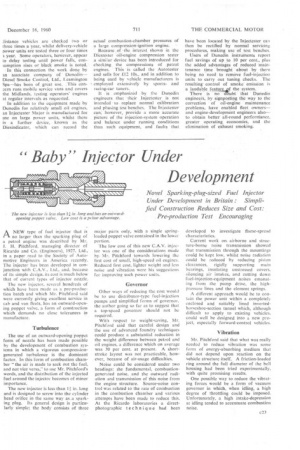C Baby" Injector Under
Page 59

If you've noticed an error in this article please click here to report it so we can fix it.
Development
• Novel Sparking-plug-sized Fuel Injector Under Development in Britain : Simplified Construction Reduces Size and Cost: Pre-production Test Encouraging
A NEW type of fuel injector that is I-1 no larger than the sparking. plug of a petrol engine was described by Mr. I. H. Pitchford, managing director of Ricardo and Co. (Engineers), 1927, Ltd., in a paper read to the Society of Automotive Engineers in America recently. The injector has been developed in conjunction with C.A.V., Ltd., and, because of itS simple design, its cost is much below that of current types of injector nozzle.
The new injector, several hundreds of which have been made as a pre-production batch and which Mr. Pitchford said were currently giving excellent service in cab and van fleets, has an outward-opening poppet valve, a form of construction which demands no close tolerances in manufacture.
Turbulence
The use of an outward-opening poppet form of nozzle has been made possible by the development of combustion systems in which a vigorous compressiongenerated turbulence is the dominant factor. In this form of combustion chamber "the air is made to seek out the fuel, and not vice versa,'! to use Mr. Pitchford's words, and the distribution of the injected fuel around the injector becomes of Minor importance.
The new injector is less than 11 in. long and is designed to screw into the cylinder head orifice in the same way as.a sparking plug. Its general design is particularly simple; the body consists of three
major parts only, with a single springloaded poppet valve contained in the lower portion.
The low cost of this new C.A.V. injector was one of the considerations made byMr. Pitchford towards lowering the first cost of small, high-speed oil engines. Reduced first cost, lighter weight and less noise and vibration were his suggestions for improving such power units.
Governor
Other ways of reducing the cost would be to use distributor-type fuel-injection pumps and simplified forms of governor, the author going so far as to suggest that a top-speed governor should not be required.
With 'respect to weight-saving, Mr. Pitchford said that careful design and the use of advanced foundry techniques could produce a substantial reduction in the weight difference between petrol and oil engines, a difference which on average was 30 per cent, at present. A shortstroke layout was not practicable, however, because of air-usage difficulties.
Noise could be considered under two headings: the fundamental, combustiongenerated noise, and the outward radiation and transmission of this noise from the engine structure. Source-noise control was related to the rate of combustion in the combustion chamber and various attempts have been made to reduce this. At the Ricardo laboratories a directphotographic t e c kn ique had been developed to investigate flame-spread characteristics.
Current work on. airborne and structure-borne noise transmission showed that transmission through the mountings could he kept low, whilst noise radiation could be reduced by reducing piston clearances, rigidly supporting main hearings, insulating unstressed covers, silencing air intakes, and cutting down fuel-injection-equipment noises emanating from the pump drive, the highpressure lines and the element springs.
A different approach would be to contain the power unit within a completely enclosed and suitably lined invertedhorseshoe-section tunnel which, although difficult to apply to existing vehicles, could well he designed into a new project, especially forward-control vehicles.
Vibration
Mr. Pitchford said that what was really needed to reduce vibration was some form of energy-absorbing medium that did not depend upon reaction on the vehicle structure itself. A friction-loaded ring around the full diameter of the bell housing had been tried experimentally, with quite promising results.
One possible way to reduce the vibrating forces would be a form of vacuum governor in which, when idling, a high degree of throttling could be imposed. Unfortunately, a high intake-depression at idling tended to accentuate combustion noise.
























































































































